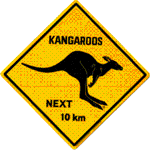|
|
|
 Port Macquarie
Port Macquarie
Ozzie Pozzie...
It's about a five hours drive from Byron Bay via Coffs Harbour (the big 'nana) and the Pacific Highway No. 1 to Port Macquarie, stops and breaks included. We reach Nomads Ozzie Pozzie, one of the three hostls in Port Macquarie that really cater for the travellers. Port Macquarie, population 33'700, is not yet reached by the mass tourism although it's well located, midway between Brisbane and Sydney on the northeast coast of New South Wales. It was a convict settlement from 1821 to 1840 and has access to the sea and to the Hastings River so it's well worth stopping on the way from Brisbane to Sydney.
The rooms in Ozzie Pozzie's are prettily furnished and have all the stuff you miss in most hostels, like wardrobes, wide beds and real linen. For 44 dollars the twin room you just have to be happy here. Dinner is free today (Mexican Chilli) and the hosts, a friendly couple, are well informed about the events in the region and very helpful.
While we are having dinner, Chris comes by looking for some tourists as he organizes sea kayak tours and has space left for two people. We accept and thus have the next day organized.
Sea Kayaking with Chris starts at ten o'clock and as the bathroom (the only disadvantage of the twin rooms) which as to be shared is occupied for more than half an hour, I'm late. Breakfast is cut short so that we don't miss Chris and the participants from the U.K., the Netherlands and Ireland. They are all okay and even Chris is more funny than at first glance, although he is a little bit lazy and chills out in the back of the double kayaks while the guy in front of him gets all the work... First part of the day leads out to the sea, where the swell is pretty high. We get all wet and have good fun crossing the waves. Surfing would be the bigger problem here for us. But riding the wave is also possible with a kayak, getting the speed is even easier with to paddles.
We reach Windmill and Flagstaff Hill, both lookouts on top of the cliffs along the coast, and turn around. The way back to the landing point in the Hastings River is far easier as wind and tide come from behind and push us into the river. We load the picknick box with all the food and hop back into the water, trying to show Chris that his construction witht he box in the back of the boat is not that stable... We have a few good laughs crossing a narrow bridge and reach the wetlands. Chris explains the eco system with the tidal mangrove trees and the renaturation projects that are ongoing. On one of these working sites, one of our boats suddenly gets stuck on a pipeline.
Mangroves are a form of vegetation that adapted to an environment rich in salt. Mangroves are normally poor in species, not more than 10 metres high and have flexible roots that find good support in the mud of the tidal areas and that improve their intake of oxigen. During the tidal movements small particles carried inside the water get stuck in the tangle of the undergrowth and accelerate the extension of land. Mangroves have a high tolerance towards salt and appropriate organes to get rid of circulating salt.
We reach the picknick area at settlement point and try to get warm again as we are all completely soaked and wet. All are hungry and the food is simple but really good. Refreshed we kayak around Pelican Island and the sandbanks and have the wind and the waves coming towards us. Most of the wave break over the flat kayaks and splash inside. The person in front of the boat gets most of it, but sometimes the waves come across and soak the participant behind as well. A few races with the other boats don't keep us dry either and in the end everybody is wet, Chris and the picknick box, now empty, included.
< >